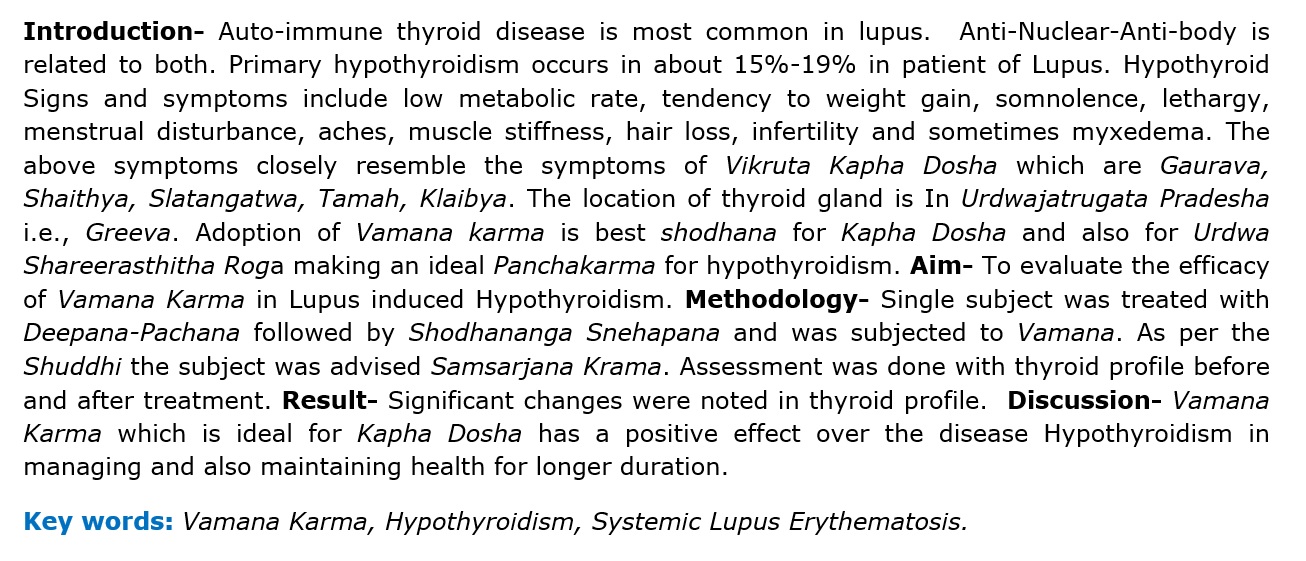A Case Study on effect of Vamana Karma in Lupus Induced Hypothyroidism
DOI:
https://doi.org/10.21760/jaims.v6i3.1338Keywords:
Vamana Karma, Hypothyroidism, Systemic Lupus Erythematosis.Abstract
Introduction- Auto-immune thyroid disease is most common in lupus. Anti-Nuclear-Anti-body is related to both. Primary hypothyroidism occurs in about 15%-19% in patient of Lupus. Hypothyroid Signs and symptoms include low metabolic rate, tendency to weight gain, somnolence, lethargy, menstrual disturbance, aches, muscle stiffness, hair loss, infertility and sometimes myxedema. The above symptoms closely resemble the symptoms of Vikruta Kapha Dosha which are Gaurava, Shaithya, Slatangatwa, Tamah, Klaibya. The location of thyroid gland is In Urdwajatrugata Pradesha i.e., Greeva. Adoption of Vamana karma is best shodhana for Kapha Dosha and also for Urdwa Shareerasthitha Roga making an ideal Panchakarma for hypothyroidism. Aim- To evaluate the efficacy of Vamana Karma in Lupus induced Hypothyroidism. Methodology- Single subject was treated with Deepana-Pachana followed by Shodhananga Snehapana and was subjected to Vamana. As per the Shuddhi the subject was advised Samsarjana Krama. Assessment was done with thyroid profile before and after treatment. Result- Significant changes were noted in thyroid profile. Discussion- Vamana Karma which is ideal for Kapha Dosha has a positive effect over the disease Hypothyroidism in managing and also maintaining health for longer duration.
Downloads
References
2. ASPI F Golwalla, Sharukh A Golwalla, Milind Y Nadkar(editor). Golwalla’s medicine for students. Jaypee Brothers Medical Publishers. 25th edition, reprint 2018, table 30, p430,431.
3. Unnikrishnan AG, Kalra S, Sahay RK, Bantwal G, John M, Tewari N. Prevalence of hypothyroidism in adults: An epidemiological study in eight cities of India. Indian J Endocrinol Metab. 2013;17(4):647-652. doi:10.4103/2230-8210.113755
4. ASPI F Golwalla, Sharukh A Golwalla, Milind Y Nadkar(editor). Golwalla’s medicine for students. Jaypee Brothers Medical Publishers. 25th edition, reprint 2018, table 30,p671.
5. https://www.hopkinslupus.org/lupus-info/lupus-signs-symptoms-comorbidities/#:~:text=The%20thyroid%20is%20the%20gland,have%20hyperthyroidism%20(overactive%20thyroid)
6. Yael Klionsky, Maria Antonelli. Thyroid disease in lupus - an updated review. ACR open Rheumatology. vol-2 (feb) pg no74-78.
7. Radha Andhare, correlation between hypothyroidism and kaphavrutta vata according to ayurved. International ayurvedic medical journal{online}dec2016 pg no 3549-3554.
8. Agnivesha, YT Acharya (ed). Charaka Samhita. Chaukhambha Orientalia, Varanasi. Sutrasthana 28th chapter, verse 9-10, 2015 edition, pg179.
9. Prakash L Hedge, Harini A. Dravya Guna Vigyana. Chaukhambha Orientalia, Varanasi. Vol 2, reprint 2019, p316, 876,611.
10. Prakash L Hedge, Harini A. Dravya Guna Vigyana. Chaukhambha Orientalia, Varanasi. Vol 2, reprint 2019, p530,192.
11. Song Y, Zhao M, Zhang H, Zhang X, Zhao J, Xu J, Gao L. Thyroid-stimulating hormone levels are inversely associated with serum total bile acid levels: a cross-sectional study. Endocr Pract. 2016 Apr;22(4):420-6. doi: 10.4158/EP15844.OR. Epub 2015 Nov 25.















